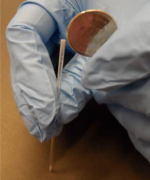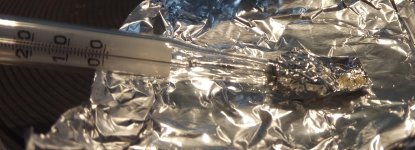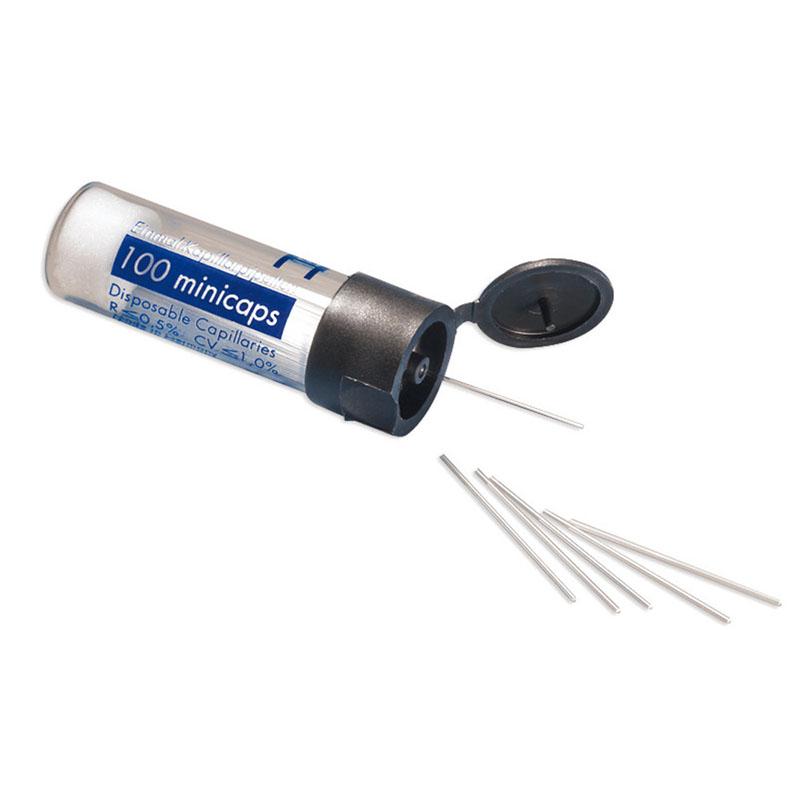G.Patton
Expert
- Joined
- Jul 5, 2021
- Messages
- 2,704
- Solutions
- 3
- Reaction score
- 2,849
- Points
- 113
- Deals
- 1
Melting point determination.
Melting point is a characteristic property of solid crystalline substances. It is the temperature at which the solid phase changes to the liquid phase. Melting point determination is the thermal analysis most frequently used to characterize solid crystalline materials. It is used in research and development, as well as in quality control in various industry segments to identify solid crystalline substances and to check their purity. This method very useful for checking your precursor or product conformity to literature data.
What Is Melting Point?
This phenomenon occurs when the substance is heated. During the melting process, all the energy added to the substance is consumed as heat of fusion, and the temperature remains constant (see diagram below). During the phase transition, the two physical phases of the material exist side-by-side.
Crystalline materials consist of fine particles that for a regular, 3-dimensional arrangement – a crystalline lattice. The particles within the lattice are held together by lattice forces. When the solid crystalline material is heated, the particles become more energetic and start to move more strongly, until finally the forces of attraction between them are no longer strong enough to hold them together. The crystalline structure is destroyed and the solid material melts.
The stronger the forces of attraction between the particles, the more energy is needed to overcome them. The more energy is needed, the higher the melting point. The melting temperature of a crystalline solid is thus an indicator for the stability of its lattice.
Crystalline materials consist of fine particles that for a regular, 3-dimensional arrangement – a crystalline lattice. The particles within the lattice are held together by lattice forces. When the solid crystalline material is heated, the particles become more energetic and start to move more strongly, until finally the forces of attraction between them are no longer strong enough to hold them together. The crystalline structure is destroyed and the solid material melts.
The stronger the forces of attraction between the particles, the more energy is needed to overcome them. The more energy is needed, the higher the melting point. The melting temperature of a crystalline solid is thus an indicator for the stability of its lattice.
Principle.
At the melting point, there is a change in light transmission. Compared to other physical values, the change in light transmission can easily be determined and can therefore be used for melting point detection. Powdered crystalline materials are opaque in the crystalline state and transparent in the liquid state. This distinct difference in optical properties can be measured in order to determine the melting point by recording the percentage of light intensity shining through the substance in the capillary, the transmittance, in relation to the measured furnace temperature.
There are different stages of the melting point process of a solid crystalline substance: at the collapse point, the substance is mostly solid and comprises only a small amount of molten material. At the meniscus point, most of the substance has melted, but some solid material is still present. At the clear point, the substance has completely melted.
There are different stages of the melting point process of a solid crystalline substance: at the collapse point, the substance is mostly solid and comprises only a small amount of molten material. At the meniscus point, most of the substance has melted, but some solid material is still present. At the clear point, the substance has completely melted.
Melting Point of an Organic Compound.
The Capillary Method.
Materials required:- Liquid paraffin in a 100ml beaker (melt a candle);
- Powdered drug;
- Thin walled capillary tube of 8-10 cm length and 1-2 mm diameter thread;
- Glass or ceramic plate;
- Thermometer stand with clamp stirrer, spatula, hot plate.
Take a capillary tube and seal one end by heating it in the flame to the burner (can use camping burner). Using the spatula or plastic card, make a heap of the powdered researched drug on the glass plate. Push the open end of the capillary tube into the heap. You can help by spatula or plastic card. Some substance will enter into the capillary tube. Now tap the sealed end of the capillary tube on the plate gently and fill the capillary tube up to 2-3 mm. Attach the capillary tube to the thermometer using the thread or rubber. Take the 100 ml beaker containing liquid paraffin and place it over the hot plate. Clamp the thermometer carrying the test tube to the iron stand and immerse them in the bath of liquid parafin. Start heating the liquid paraffin bath slowly and stir the bath gently using the stirrer to ensure uniform heating. Note the temperature t1 when the substance starts melting. Continue heating and note the temperature t2 when the substance in the capillary tube is completely melted. The average of the two temperatures t1 and t2 gives the melting point of your drug.
Important: use dry and powdered sample for the determination of melting point; packing of the powder should be uniform without any big air gaps between the solid particles; the liquid paraffin bath must be heated very slowly and the path is stirred gently to ensure uniform heating. The bulb of the thermometer and the capillary attaching to it should not touch the sides or the bottom of the beaker.


The air Method.Important: use dry and powdered sample for the determination of melting point; packing of the powder should be uniform without any big air gaps between the solid particles; the liquid paraffin bath must be heated very slowly and the path is stirred gently to ensure uniform heating. The bulb of the thermometer and the capillary attaching to it should not touch the sides or the bottom of the beaker.
Materials required:
- Thermometer;
- Spatula or plastic card;
- Hot plate;
- Powdered drug;
- Roll foil.
Cut a square of the foil and put it on the heating plate. Fold the foil in two layers and wrap around the thermometer bulb. Take a couple drug lumps and put them on prepared foil. Start heating it slowly (5-7 degrees per minute). Note the temperature t1 when the substance starts melting. Continue heating and note the temperature t2 when the substance in the capillary tube is completely melted.
There are pictures of melting point experiment with methamphetamine. Literature data shows 170-175 degree for d- and l-methamphetamine hydrochloride, but a mixture of equal amounts of both optical isomers (racemic mixture) has a lower melting point (130-135 °C). Experimental result shows 174 degree, which correspond with literature data for one (d- or l-) isomer.
There are pictures of melting point experiment with methamphetamine. Literature data shows 170-175 degree for d- and l-methamphetamine hydrochloride, but a mixture of equal amounts of both optical isomers (racemic mixture) has a lower melting point (130-135 °C). Experimental result shows 174 degree, which correspond with literature data for one (d- or l-) isomer.
Experiments with amphetamine and mephedrone were provided as well.


 Literature data shows 280-281 degree for amphetamine sulphate. Experimental result shows 189 degree.
Literature data shows 280-281 degree for amphetamine sulphate. Experimental result shows 189 degree.


 Literature data shows 205.25 degree for mephedrone hydrobromide. Experimental result shows 206 degree.
Literature data shows 205.25 degree for mephedrone hydrobromide. Experimental result shows 206 degree.
Results and discussion.
The experiment with methamphetamine lump shows that it is one (d- or l-) isomer. The amphetamine melting point does not correspond with the literature data. There are several reasons: not so much pure amphetamine; big infelicity of method or substituted substance. The mephedrone melting point does not match 11 degree, which can be considered a method of infelicity.
Conclusion.
Both of method have advantages and disadvantages. Capillary method takes a lot of efforts and materials to carry out it, but you get more exactly result of melting point experiment. Air melting experiment very easy to handle and easy to get materials, but you obtain result with big infelicity and have to approve it several times. Anyway, you can choose an appropriate method for your goal and figure out melting point of interested drug.
Results and discussion.
The experiment with methamphetamine lump shows that it is one (d- or l-) isomer. The amphetamine melting point does not correspond with the literature data. There are several reasons: not so much pure amphetamine; big infelicity of method or substituted substance. The mephedrone melting point does not match 11 degree, which can be considered a method of infelicity.
Conclusion.
Both of method have advantages and disadvantages. Capillary method takes a lot of efforts and materials to carry out it, but you get more exactly result of melting point experiment. Air melting experiment very easy to handle and easy to get materials, but you obtain result with big infelicity and have to approve it several times. Anyway, you can choose an appropriate method for your goal and figure out melting point of interested drug.
There are melting temperatures of some drugs and precursors:
Drugs:
Amphetamine sulphate, 280-281 °C;
Methamphetamine, 170-175 °C;
Mephedrone hydrochloride, 251.18 °C and Mephedrone hydrobromide 205.25 °C;
Cocaine hydrochloride, 197 °C;
Phencyclidine hydrochloride, 243-244 °C;
MDMA hydrochloride, 147-153 °C;
a-PVP hydrochloride, 162-173 °C;
MDA Hydrochloride, 187-188 °C;
Ephedrine hydrochloride, 217-220 °C;
Methcathinone hydrochloride, 188-191 °C;
2C-B hydrochloride, 236-238 °C;
Mescaline hydrochloride, 180-182 °C;
Methylone hydrochloride (MDMC), 236-238 °C;
DMT (free base) 42-47 °C;
DMT Fumarate 152 °C;
Psilocybin 220-228 °C;
Ergotamine 241-249 °C;
JWH-018 55-59 °C;
UR-144 68 °C;
JWH-1503 91-97 °C;
AM-2201 80 °C;
JWH-210 90 °C;
JWH-122 89 °C;
JWH-081 127 °C;
JWH-073 100 °C;
Methadone hydrochloride, 232-234 °C;
Diacetylmorphine hydrochloride (heroin) 229-233 °C;
Codeine monohydrate, 154-156 °C.
Precursors:
2,5-Dimethoxybenzaldehyde 50 °C;
2,5-Dimethoxy-4-methylbenzaldehyde 82-86 °C;
Piperonal 37 °C;
3,4,5-trimethoxybenzaldehyde 73-76 °C;
Phenyl-2-nitropropene 64-66 °C;
2-Bromo-4-methylpropiophenone 75-77 °C;
4-Cyano-2-dimethylamino-4,4-diphenylbutane 88-91 °C;
Methamphetamine, 170-175 °C;
Mephedrone hydrochloride, 251.18 °C and Mephedrone hydrobromide 205.25 °C;
Cocaine hydrochloride, 197 °C;
Phencyclidine hydrochloride, 243-244 °C;
MDMA hydrochloride, 147-153 °C;
a-PVP hydrochloride, 162-173 °C;
MDA Hydrochloride, 187-188 °C;
Ephedrine hydrochloride, 217-220 °C;
Methcathinone hydrochloride, 188-191 °C;
2C-B hydrochloride, 236-238 °C;
Mescaline hydrochloride, 180-182 °C;
Methylone hydrochloride (MDMC), 236-238 °C;
DMT (free base) 42-47 °C;
DMT Fumarate 152 °C;
Psilocybin 220-228 °C;
Ergotamine 241-249 °C;
JWH-018 55-59 °C;
UR-144 68 °C;
JWH-1503 91-97 °C;
AM-2201 80 °C;
JWH-210 90 °C;
JWH-122 89 °C;
JWH-081 127 °C;
JWH-073 100 °C;
Methadone hydrochloride, 232-234 °C;
Diacetylmorphine hydrochloride (heroin) 229-233 °C;
Codeine monohydrate, 154-156 °C.
Precursors:
2,5-Dimethoxybenzaldehyde 50 °C;
2,5-Dimethoxy-4-methylbenzaldehyde 82-86 °C;
Piperonal 37 °C;
3,4,5-trimethoxybenzaldehyde 73-76 °C;
Phenyl-2-nitropropene 64-66 °C;
2-Bromo-4-methylpropiophenone 75-77 °C;
4-Cyano-2-dimethylamino-4,4-diphenylbutane 88-91 °C;
Attachments
Last edited:



